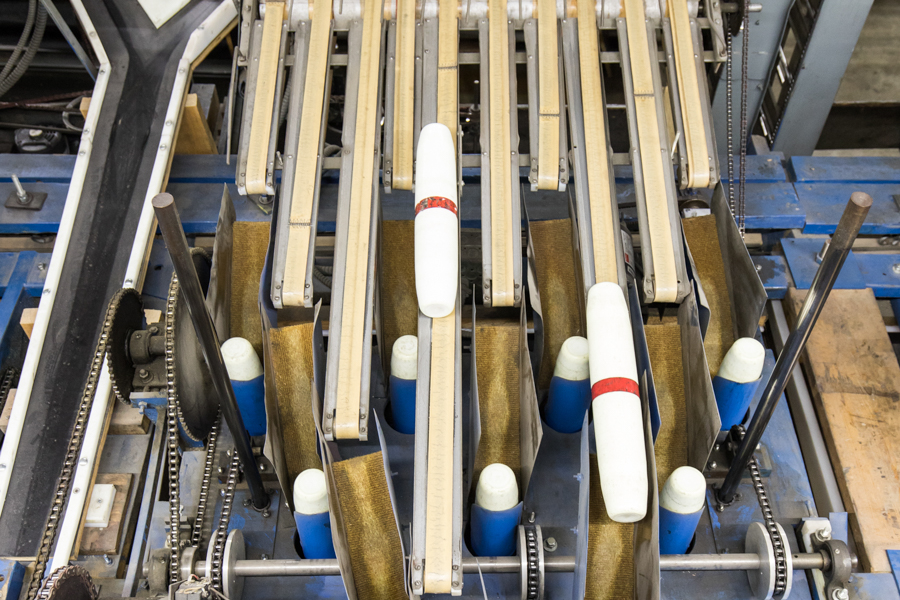Have you ever wondered about the game of “candlepins”, how it got it start and why it has become so popular? A look back at the history of candlepins and one will soon realize that developing the game has been as challenging as the game itself.
Although there may be some minor differences of opinion, it has generally accepted throughout the candlepin bowling industry that the game was introduced sometime between 1885 and 1890. No one knows the exact date, but several references indicate that the game has been in existence for more than 100 years – with Worcester, Massachusetts as its birthplace.
It seems that three men – Justin P White, Jack Monsey and Jack Sheafe were credited with the creation of this unique game. Information suggests that the original pins were 10” inches high, 1 inch in diameter and set 11” apart. These pins, arranged in a triangular design 50 feet away, (that distance varied) gave the appearance of candles, and thus, the name “candlepins” originated.
It soon became apparent, however, that pins with those dimensions were very difficult to knock down. A bowling ball that measured 3 inches in diameter and weighed approximately 2 pounds, added yet another ingredient to further frustrate its participants
In its’ infancy, pin and ball were made of hardwood, leaving much to be desired with regard to uniformity.
The first rules also required the removal of felled pins (deadwood) from the playing area – a rule borrowed from the game of ten pins which was already in existence at the time.
Faced with all these negative features, one would think that candlepins were certain to be short-lived. However, time has proved otherwise.
Recognizing the problems and determined that there was indeed a future in candlepin bowling, it was back to the drawing board for these pioneers hoping that an exchange of new ideas and renovations would produce more favorable attitudes and better scores among its players.
Their efforts led to the introduction of a pin size that we know today – 15 ¾ inches in length, 1 ¾ inches at each end and 2 15/16 inches at the center. The three men also reasoned that the felled pins which lie fairly in the playing area should remain, thus giving the bowler an added advantage. It has been proven time again, however, that the “deadwood” does not always favor the player.
Still another important adjustment involved the bowling ball. Its size was increased from 3 inches to a maximum of 4 ½ inches in diameter and its weight to a maximum of 2 pounds 7 ounces. The combination of adjustments did, in fact, improve the scoring considerably.
In the 1940’s and 50’s when pin boys were still a synonymous part of bowling, any kegler who could maintain an average of 105 – 110 was truly an outstanding performer.
Today’s superstars are flirting with averages close to the 140 mark. One may ask, what has brought about this big change?
First of all, the days of the pin boy have long since passed, his job having been replaced by a machine. This automatic marvel is capable of“spotting” pins exactly each and every time. Since the arrangement of the pins is scientifically designed, exact placement is a must. Any pin slightly off the “spot” would have an enormous effect in the way the pins react upon contact with the ball.
Perhaps the second most notable development affecting today’s improved scores was the introduction of the plastic pin. This durable friend, in addition to being livelier than its wooden predecessor, has a much longer life expectancy and maintains its original shape for a much longer period of time. The plastic pin has been a blessing for both the bowling proprietor and player since it minimizes pinsetter breakdowns and delays. Furthermore, the plastic pin assures greater consistency and predictability when contact is made with the ball.
And finally there is a much-improved bowling ball – also of a plastic synthetic composition, much truer in shape and weight than the earlier ones and available in a variety of attractive color combinations.
Although there have been numerous other bowling related products on the market over the years, the pinsetter, the plastic pins, and the improved ball are the most significant manufactured products contributing to the revolutionizing and advancement of candlepin bowling.
Aside from all of man’s innovations, however, the spotlight has to shine equally bright on its most important counterpart – the bowler. Never before have there been so many participants in a single sport or recreational activity. It is estimated that 1 out of 3 people take part regularly in some form of bowling. And never before have there been so many incentives. Today’s most serious and competitive bowlers have an excellent opportunity to add to their income while enjoying a favorite pastime. Such promotions as television, state tournaments, Pro Bowlers tour, interstate, and local tournaments are but a few of the many activities available through all MBA member bowling establishments.
Financial rewards and media exposure have played an important part in inspiring bowlers to achieve incredible results. Practice, concentration and determination are the key words for those seeking “professional” status.
One would agree that the modern technology combined with individual skills can be credited to today’s much-improved scores and increasing popularity.
But for the most part, candlepin bowling spells enjoyment for all ages. For those who are not competitively motivated, having fun is the ideal inducement. Family participation and social gathering make up a large part of the bowling population. Unlike ten pin, youngsters and old-timers alike adapt to this “small ball” game with ease.
In spite of fluctuating economic trends over the years, and especially during high inflation and recession periods, candlepin bowling has always been considered one of the days best buys. Perhaps this is the reason that candlepin bowling centers have often been referred to as the “poor man’s country club”.
Although the game of candlepin is confined to a relatively small section of New England, proprietors defend their game and their territory fiercely…and rightfully so. To them, the game of candlepins offers the most challenging of all indoor sports.
Consider, if you will, that in more than 100 years of candlepin bowling, no one has yet to achieve a perfect “300” game. What’s more, it’s unlikely that anyone ever will.(The record single game score recognized by the MBA is 245 for the men and 196 for the women). With this elusive goal ever present, “challenging” does indeed describe this game of uncanny skill.

